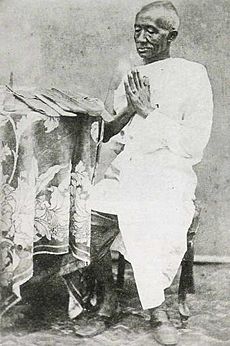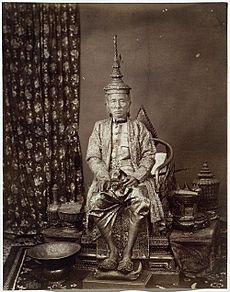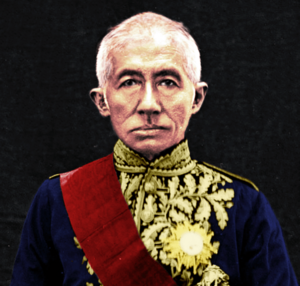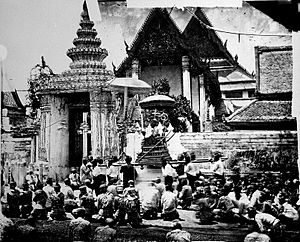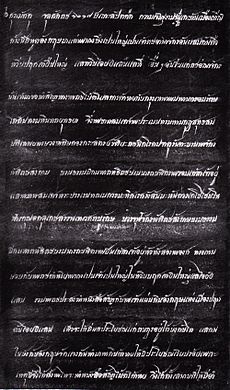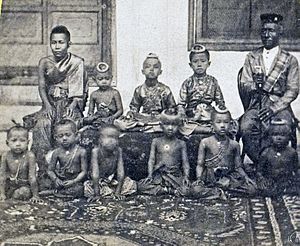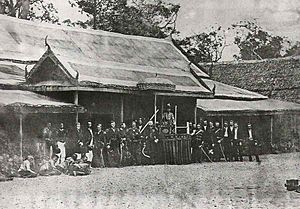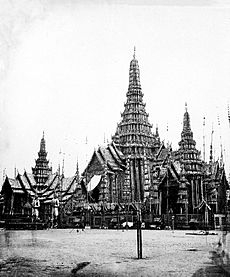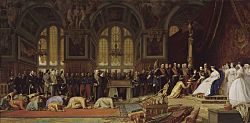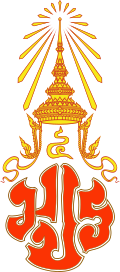Mongkut facts for kids
Quick facts for kids Mongkutมงกุฎ |
|
|---|---|
| King Rama IV | |
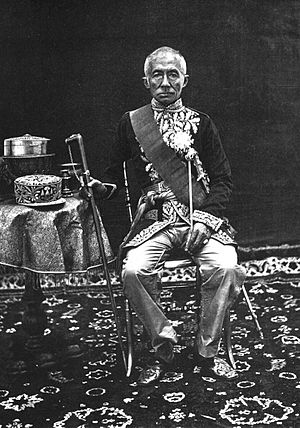
Mongkut c. 1865
|
|
| King of Siam | |
| Reign | 2 April 1851 – 1 October 1868 |
| Coronation | 15 May 1851 |
| Predecessor | Nangklao (Rama III) |
| Successor | Chulalongkorn (Rama V) |
| Viceroy | Pinklao |
| Born | 18 October 1804 Thonburi Palace, Bangkok Yai, Bangkok, Siam |
| Died | 1 October 1868 (aged 63) Grand Palace, Phra Nakhon, Bangkok, Siam |
| Spouse | Somanass Waddhanawathy Debsirindra Pannarai and 77 concubines |
| Issue Detail |
39 sons and 43 daughters, including: Chulalongkorn (Rama V) |
| House | Chakri |
| Father | Buddha Loetla Nabhalai (Rama II) |
| Mother | Bunrot of Rattanakosin |
| Religion | Theravada |
| Signature | |
| Mongkut | |
|---|---|

Privy Seal
|
|
| Thai name | |
| Thai | พระบาทสมเด็จพระจอมเกล้าเจ้าอยู่หัว |
| RTGS | Phra Bat Somdet Phra Poramenthra Ramathibodi Srisin Maha Mongkut Phra Chom Klao Chao Yu Hua |
Mongkut (Thai: มงกุฏ; 18 October 1804 – 1 October 1868) was the fourth king of Siam (now Thailand) from the House of Chakri. He was known as Rama IV and ruled from 1851 to 1868.
Outside Thailand, King Mongkut is famous for being the king in the 1951 musical and 1956 film The King and I. These were based on a 1944 novel about Anna Leonowens, who worked at his royal court from 1862 to 1867.
During Mongkut's time, Siam faced pressure from Western countries that were expanding their empires. King Mongkut welcomed new ideas from the West and started modernizing his country. He introduced new technology and changed some cultural practices. This earned him the nickname "The Father of Science and Technology" in Siam.
Mongkut also made his younger brother, Prince Chutamani, a "Second King" named Pinklao in 1851. Mongkut wanted Pinklao to be respected just as much as himself. During his rule, the powerful Bunnag family became very influential in Siam.
Contents
Early Life and Royal Family
Mongkut (which means crown) was born in 1804 at the Thonburi Palace. He was the second son of Prince Isarasundhorn, who later became King Rama II. Mongkut's older brother had died shortly after birth. In 1808, his younger brother, Prince Chutamani (Pinklao), was born.
When their father became King Rama II in 1809, the royal family moved to the Grand Palace. From then on, Mongkut and Chutamani were known as Chao Fa Yai and Chao Fa Noi, which means "Big Prince" and "Little Prince."
Life as a Monk and Religious Changes
In 1824, Mongkut became a Buddhist monk, as was the tradition for men aged 20 in Siam. That same year, his father died. By tradition, Mongkut should have been the next king. However, the powerful nobles chose his older, more experienced half-brother, Prince Nangklao (Rama III), to be king instead. To avoid political problems, Mongkut decided to remain a monk.
As a monk, Mongkut, known as Vajirayan, traveled across the country. He noticed that many Siamese monks were not strictly following the rules of Buddhism. In 1829, he met a monk who followed the rules very carefully, which inspired Mongkut to seek religious reforms.
In 1835, he started a movement to bring back strict adherence to Buddhist rules. This movement grew into the Dhammayuttika Nikaya, a new branch of Buddhism. Mongkut believed that "true Buddhism should stay away from worldly matters and focus on spiritual and moral things." When he became king in 1851, his ideas helped Siam embrace modernization more quickly.
Mongkut also learned about Western subjects like geography and astronomy from missionaries and sailors. He even became friends with a Catholic priest, Vicar Jean-Baptiste Pallegoix, and invited him to preach in his temple. Mongkut admired Christian morals but found their beliefs confusing. He once said, "What you teach people to do is admirable, but what you teach them to believe is foolish."
King Mongkut became very good at English. His son, Chulalongkorn, later officially recognized the Dhammayut sect in 1902, making it one of the main Buddhist groups in Thailand today.
Becoming King and His Rule
After 27 years as a monk, Prince Mongkut left the monkhood and became king in 1851, at age 47. He was given the name Phra Chom Klao, but foreigners continued to call him King Mongkut. He was seen as friendly towards the British.
King Mongkut knew that European powers might try to take over Siam. To show that Siam was a modern nation, he ordered his nobles to wear shirts when they came to court. Before this, nobles often went bare-chested to show they weren't hiding weapons.
Mongkut believed his brother, Prince Isaret (Pinklao), was also destined to be king. So, he crowned Pinklao as the Second King. Pinklao was known for his skills in foreign languages and international relations. Mongkut also gave great power to his supporter, Dis Bunnak, making him a top noble and his main regent. Dis Bunnak's brother, Tat Bunnak, also became a regent in Bangkok. This meant the two Bunnaks held much of Siam's administrative power.
After becoming king, Mongkut married Queen Somanat, but she died the same year. He then married his half-grandniece, Mom Chao Rampoei Siriwongse, who became Queen Debsirindra. King Mongkut had many children, 82 in total, with 32 wives and concubines.
Shan Campaigns
In 1849, there were conflicts in the Shan States of Kengtung and Chiang Hung. Chiang Hung asked Siam for help. King Nangklao saw this as a chance to control the Shan states, but he died before his plan could be carried out. In 1852, Chiang Hung asked again, and Mongkut sent troops north. However, the mountainous land made it hard for the armies to advance. In 1855, the Siamese army tried again and reached Kengtung, but they ran out of supplies and had to retreat.
Cultural and Social Changes

Learning About Western Geography
When Westerners came to Siam, they brought the idea that the Earth was round. Many Siamese people found this hard to believe because Buddhist texts described the Earth as flat. However, religious scholars often explained that Buddhist scriptures should be taken literally only for spiritual truths, while details about nature were often symbolic.
Mongkut said he already knew the Earth was round 15 years before American missionaries arrived. He encouraged his royal relatives to get a "European-style education." Missionaries taught modern geography, astronomy, and other subjects. This helped bring reforms to education in Siam.
Other Social Changes
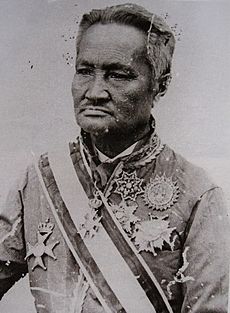
In 1852, many English and American missionaries came to Siam. Mongkut hired them to teach English to the princes. He also hired Western soldiers to train Siamese troops in Western ways. In Bangkok, an American named Dan Beach Bradley started publishing Siam's first newspaper, the Bangkok Recorder.
King Mongkut also improved women's rights. He allowed many royal concubines to leave the palace and marry. He also banned forced marriages and the selling of one's wife to pay off debts.
Unlike the previous king, Mongkut did not send envoys to the Qing dynasty court in China. This was because such missions showed Siam's submission to the Chinese emperors, and the Qing dynasty was no longer as powerful as it used to be.
The Bowring Treaty
In 1854, John Bowring, the governor of British Hong Kong, came to Siam to negotiate a treaty with the British Queen Victoria. This was the first time Siam had to seriously deal with international laws. The result was the Bowring Treaty in 1855.
A key part of the treaty was ending the Royal Storage system, which had controlled all foreign trade since the Ayutthaya Kingdom era. This system had brought a lot of money to Siam by heavily taxing foreign traders. The Bowring Treaty replaced this with free trade. Import taxes were greatly reduced, which hurt the government's income. However, it led to a huge increase in trade as ordinary people could now trade with foreigners.
The treaty also had legal effects. Because of harsh torture methods used in Siamese courts, the British demanded that their citizens in Siam only be tried under British law. This was called extraterritoriality. Siam did not get the same privilege for its citizens in Britain.
More treaties were signed with other countries, further reducing Siam's income and legal control. The Bowring Treaty brought big economic and social changes to Siam. For the first time, there was a lot of commercial activity, and Siam started using coins in 1860. New industries like rice milling and sugar production began. Roads were paved, and canals were dug to improve transport and provide water for farms.
Anna Leonowens
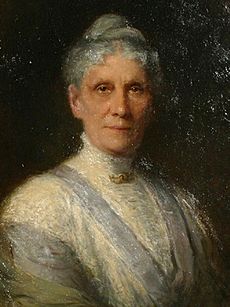
In 1862, King Mongkut hired an English woman named Anna Leonowens to teach English to the royal children. Her time at the court later became a topic of much discussion in Thailand.
Around 1870, Anna Leonowens wrote a memoir about her experiences. An author named Margaret Landon later used this memoir to write a more fictionalized book, Anna and the King of Siam, in 1944. This book was then adapted into films and a musical.
The Hollywood movies Anna and the King of Siam and Anna and the King, as well as the musical The King and I, were based on this story. However, these works are banned in Thailand because they are seen as disrespectful to King Mongkut and contain historical inaccuracies. To set the record straight, Thai intellectuals Seni and Kukrit Pramoj wrote The King of Siam Speaks in 1948.
Anna Leonowens claimed that her talks with Prince Chulalongkorn about freedom, and her telling him the story of Uncle Tom's Cabin, inspired him to end slavery in Siam almost 40 years later. In Siam, slavery was sometimes a choice for people to get out of debts. Slaves could also buy their freedom, and some Western observers thought Siamese slaves were treated better than English servants.
Death and Legacy
Predicting the Solar Eclipse
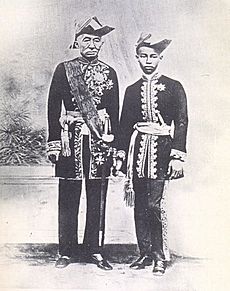
During his time as a monk, King Mongkut studied both traditional Siamese astrology and Western astronomy and mathematics. He became very skilled at measuring the stars. He even changed the official Buddhist calendar because it had errors.
In 1868, he invited important European and Siamese officials to join him in Wakor village, Prachuap Khiri Khan Province. He had accurately predicted that a total solar eclipse would be best seen from there on August 18. His calculations were correct. When he returned, he criticized the court astrologers for not using modern tools for their predictions.
Sadly, during this trip to Wakor, King Mongkut and Prince Chulalongkorn both caught malaria. The king died six weeks later in the capital. His son, Chulalongkorn, survived the illness and became the next king.
Many believe that Siam's adoption of Western geography and astronomy helped show that Siam was as knowledgeable as Western countries. This may have helped prevent Siam from being colonized by Western powers.
The Elephant Story
| Monarchs of the Chakri dynasty |
|
|---|---|
| Phra Buddha Yodfa Chulaloke (Rama I) |
|
| Phra Buddha Loetla Nabhalai (Rama II) |
|
| Nangklao (Rama III) |
|
| Mongkut (Rama IV) |
|
| Chulalongkorn (Rama V) |
|
| Vajiravudh (Rama VI) |
|
| Prajadhipok (Rama VII) |
|
| Ananda Mahidol (Rama VIII) |
|
| Bhumibol Adulyadej (Rama IX) |
|
| Vajiralongkorn (Rama X) |
|
Contrary to a popular story, King Mongkut did not offer war elephants to US President Abraham Lincoln during the American Civil War. However, he did offer to send some domesticated elephants to US President James Buchanan to help with heavy work and transportation. This royal letter was written in 1861, before the Civil War began, and reached Washington D.C. after Buchanan had left office.
Lincoln, who became president after Buchanan, politely declined the offer in 1862. He explained that the American climate might not be good for elephants and that American steam engines could do the same work.
A century later, in 1960, King Bhumibol Adulyadej of Thailand, who was Mongkut's great-grandson, spoke about this event to the US Congress. He said that his great-grandfather's offer was simply "to provide a friend with what he lacks."
151834 Mongkut
An asteroid, 151834 Mongkut, is named in honor of King Mongkut. This recognizes his important contributions to astronomy and the modernization of Siam.
Tributes
Phrachomklao Hospital in Phetchaburi province is named after him.
Wives, Concubines, and Children
King Mongkut had 32 wives and concubines during his life. He had at least 82 children, including Chulalongkorn, who later became King Rama V.
See also
 In Spanish: Mongkut para niños
In Spanish: Mongkut para niños
- Dhammayuttika Nikaya
- Rattanakosin period
- List of people with the most children
- Chum Krairoek


